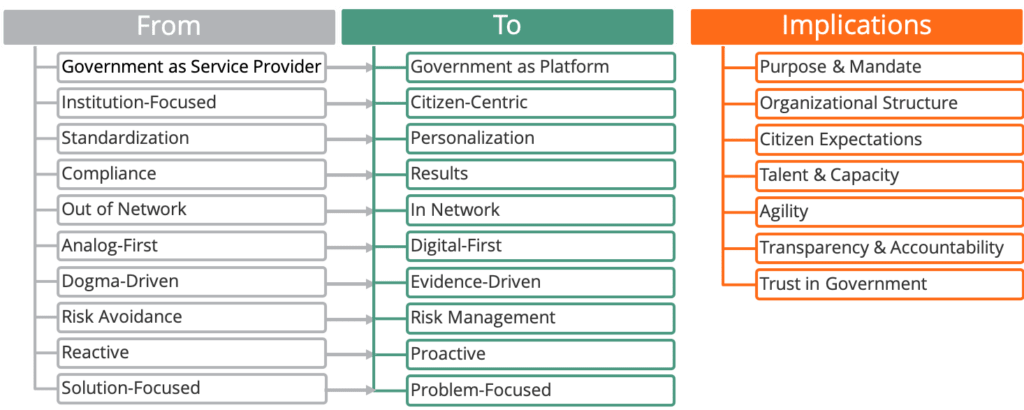For government leaders seeking to improve their country’s public financial management, digital transformation is more than a buzzword – it’s a strategic imperative.
However, the term “digital transformation” is used to describe a number of activities. As we noted in a previous article, simply using digital technology does not mean digital transformation: it is important to grasp the distinctions between digitization, digitalization, and digital transformation. Choosing the correct type of activity for PFM reform depends on the country’s context, the government’s strategic aims and the capacity of civil servants to change culture at scale.
Finance leaders who apply these concepts effectively in the context of public finance will be better positioned to lead their organizations into a future where technology is a catalyst for innovation and efficiency.
Deciphering Digital, Digitization, and Digitalization: A Spectrum of Evolution
The International Monetary Fund (IMF) provides a solid foundation for understanding this complex area by defining digital solutions. It describes digitization as a simple replication of manual processes in digital form. Digitalization, on the other hand, involves the complete automation of a process, while digital transformation goes beyond automation to reengineering and optimization.
The Gartner Group, a renowned technology analyst, contributes valuable insights by characterizing digitization as the transition from analog to digital, emphasizing the preservation of the existing process. Digitalization, in Gartner’s lens, is the strategic use of digital technologies to revolutionize business models and unearth new revenue streams. However, Gartner warns against the common misconception of using digital transformation to describe mere online service deployment or legacy modernization in public-sector organizations.
Both sets of definitions are helpful, however don’t necessarily take into account the nuances of public sector finances. With almost 40 years of experience working with governments around the world, FreeBalance offers a distinct perspective which aligns with IMF and Gartner principles, but specifically addresses the unique needs of governments.
Digitization of government data
We define public finance digitization as the conversion of manual financial processes, such as budget requests or expense reports, into digital formats. Each of the products in the FreeBalance Accountability SuiteTM delivers efficiencies through digitization of government information.
For example, FreeBalance (GPM) Government Performance Management enables easy printing of annual budget books and (PEM) Public Expenditure Management allows quick generation of purchase orders or requisitions.
Public sector digitalization
Digitalization extends beyond mere replication by encompassing the automation of entire processes, such as procure-to-pay or recruit-to-retire. For example, FreeBalance (PFM) Public Financials Management integrates authorized budgets with commitment controls and budget transfers.
Digital transformation for maximum impact
Digital transformation, defined as rethinking and reengineering processes based on digital technology, enables governments to reform their public financial management practices. This comprehensive overhaul of processes based on digital technology can encompass initiatives ranging from IT modernization, including the adoption of cloud computing, to digital optimization and the invention of innovative digital business models.
Digital transformation goes beyond simply moving to using digital tools. It involves rethinking processes and changing organizational culture:

These innovations not only streamline processes but also capitalize on the potential of digital solutions for enhanced efficiency, transparency, and overall effectiveness in public financial management.
For example, FreeBalance (CSM) Civil Service Management software not only houses HR information such as attendance and assignment data, it can be configured to fully support transformation of HR operations to better deliver against organizational strategy.
The impact of incorrect definition
The caution raised by Gartner about the term “digital transformation” being sometimes used for more modest initiatives underscores the need for a nuanced understanding in the public sector. Mislabeling smaller-scale digitization or digitalization programs as “digital transformation” can lead to a series of interconnected challenges that hinder the organization’s ability to truly modernize and optimize its public financial management processes.
The confusion between “digitization,” “digitalization,” and “digital transformation” can hinder effective decision-making and progress. Issues which can arise include:
- Misaligned expectations among stakeholders, including government officials, employees, and the public. If smaller-scale digitization efforts are erroneously communicated as transformative, there is a risk of creating unrealistic expectations regarding the depth and scope of the changes that will occur in public financial management processes.
- Inefficient resource allocation, meaning either a digital transformation project does not receive enough support, or a digitization effort receives more resources than needed, at the expense of other critical areas.
- Failure to leverage technological potential, for example through settling for digitization when a more comprehensive digitalization or digital transformation is needed, or missing an opportunity for wider innovation.
- Resistance to change, as stakeholders may perceive smaller-scale digitization efforts as disruptive transformations.
- Difficulty in measuring performance due to confusion around the scale of improvement expected.
Overcoming Challenges and Embracing Continuous Evolution
Implementing true digital transformation in public finance is not without its challenges. As we have seen, even defining the appropriate scope and term for a programme of work can be tricky. In addition, finance leaders must navigate issues such as cybersecurity concerns, workforce readiness, and the integration of new technologies. And all of this must be worked through within the individual country’s political, economic and social contexts as there is no ‘one size fits all’ approach.
FreeBalance has almost 40 years’ experience in helping countries to build effective PFM reform programs. We partner with governments to analyze their unique needs and configure software solutions which revolutionize fiscal operations. The FreeBalance approach to PFM includes the development of numerous tools that we typically use in sequence:

These techniques have adapted over time based on our experience with many global governments. To find out more about how FreeBalance can support your organization to navigate digital transformation, speak with one of our public financial management experts.
